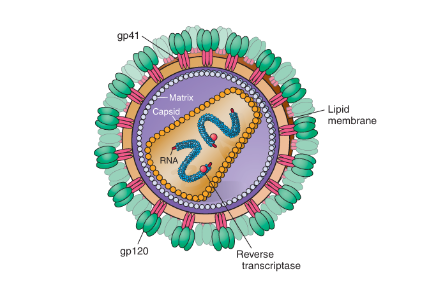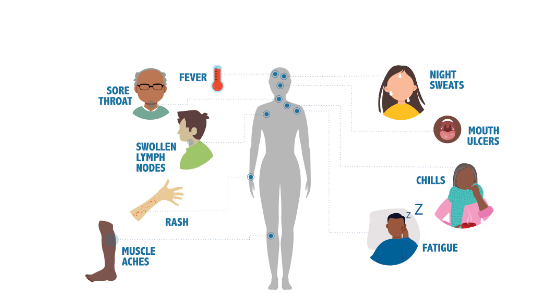By: Thalia Kaylyn Averil
Human Immunodeficiency Virus (HIV) is a virus that affects the immune system by attacking white blood cells. If left untreated, HIV can progress to Acquired Immunodeficiency Syndrome (AIDS) several years later. A weakened immune system can increase the risk of contracting infections and several other diseases. AIDS was first identified in 1981 in the United States when the Center for Disease Control and Prevention (CDC) reported cases of pneumonia in Los Angeles and cases of malignant tumors in New York and Los Angeles in homosexual men. After that, this disease spread to injecting drug users, blood transfusion recipients, and hemophilia patients. In 1983, HIV was isolated from a lymphadenopathy patient, then definitively determined to be the cause of AIDS in 1984. HIV is a serious global health problem. Currently, HIV has claimed approximately 40.4 million lives and continues to spread throughout the country, with several countries even reporting an increase in the number of new infections.

Figure 1. Human Immunodeficiency Virus (HIV).
Signs and symptoms of HIV vary based on the stage of infection. Once infected, the disease spreads more easily in the early months, but many people are not aware of the condition until much later. Most patients may not show any symptoms for several weeks. Patients may also experience flu-like symptoms such as fever, rash, sore throat, and headache. These symptoms may occur for several days or several weeks. HIV can cause a weakened immune system which is characterized by several other indicators such as enlarged lymph nodes, decreased body weight, diarrhea, or coughing. However, these signs and symptoms are not the main indicators of HIV because similar signs and symptoms can also be caused by other conditions. Therefore, a more accurate diagnosis of HIV can be done with a rapid test.

Figure 2. Symptoms that may arise in HIV patients.
HIV can only spread through bodily fluids such as blood, semen, vaginal fluids, anal fluids and breast milk from infected patients. HIV can also be transmitted from mother to child during pregnancy, childbirth, or while breastfeeding through breast milk. HIV can be transmitted if the fluid comes into contact through mucous membranes, injured tissue, sexual intercourse, or is injected directly into the bloodstream. HIV cannot be transmitted through normal everyday contact, such as kissing, hugging, shaking hands, or sharing food or drink. However, HIV patients on antiretroviral therapy (ART) cannot spread the virus to their partners. Therefore, treatment and early access to antiretroviral therapy (ART) are crucial to improving the health of people living with HIV and stopping the spread of the virus.
HIV cannot be cured, but antiretroviral therapy (ART) can be used to prevent the virus from replicating in the body and reduce its viral load. Current antiretroviral therapy (ART) can help strengthen the immune system to better fight against other diseases. Antiretroviral therapy (ART) must be taken every day throughout life. HIV patients who are on antiretroviral therapy and do not have detectable virus in their blood cannot transmit the infection to their partners.
There are several conditions and behaviors that can increase a person’s risk of contracting HIV, which are:
- Sex without using a condom
- Having another sexually transmitted disease, such as bacterial vaginosis, syphilis, herpes, chlamydia, or gonorrhea
- Using drugs and alcohol
- Sharing syringes, needles, injectable drugs, and other injectable equipment
- Accidentally pricked by an infected syringe
- Getting a non-sterile blood transfusion, tissue transplant, surgery, or piercing
HIV is a disease that can be avoided with several actions such as:
- Use a condom during sex
- Avoid drug use
- Routinely undergo tests for HIV and other sexually transmitted diseases
- Carry out treatment for mothers infected with HIV during pregnancy to prevent transmission from mother to child
- Avoid breastfeeding for HIV positive mothers to prevent transmission
- Have a piercing or blood transfusion in a sterile place
Resources
- Kasper DL, Fauci AS. Harrison’s infectious diseases. 3rd ed. New York: McGrawHill; 2016.
- World Health Organization. HIV and AIDS [Internet]. Geneva: World Health Organization; 2023 Jul 13 [cited 2024 Jul 7]. Available from: https://www.who.int/news-room/fact-sheets/detail/hiv-aids?gad_source=1&gclid=Cj0KCQjw-ai0BhDPARIsAB6hmP5V44oVwx_pSYsFjS8iektHEdvp_cYlfa7GaxfQhvDHrvadKq272roaAn9gEALw_wcB
- Center for Disease Control and Prevention. About HIV [Internet]. Georgia: Center for Disease Control and Prevention; 2024 Jan 24 [cited 2024 Jul 7]. Available from: https://www.cdc.gov/hiv/about/index.html
